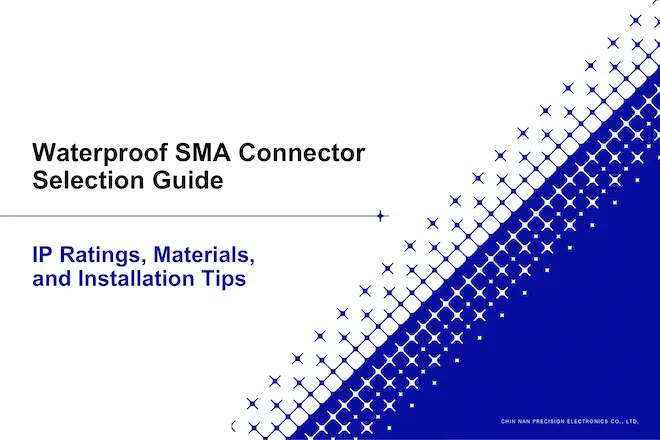Low-Loss SMA Coaxial Connectors Explained | The Key to Stable RF Signal Transmission

Waterproof SMA Connector Selection Guide|IP Ratings, Materials, and Installation Tips
Why Do Standard SMA Connectors Fail Outdoors After Just One Season?
When designing outdoor RF systems or IoT deployments, you may have experienced issues like:
“I installed a standard SMA connector, but every time it rains, the signal keeps dropping out.”
“Why does the outdoor base station start rusting within six months, and the RF signal becomes unstable?”
The reality is that outdoor, seaside, automotive, or high-humidity environments demand far higher levels of waterproofing and weather resistance from RF connectors. Many SMA connectors marketed as “waterproof” vary widely in performance: some last for years, while others fail after only a few months.
This guide explains the key factors for selecting a truly reliable waterproof SMA connector, covering IP ratings, materials, sealing design, high-frequency performance, and installation practices.
Do IP Ratings Really Matter for Waterproof SMA Connectors?
Yes. IP (Ingress Protection) ratings define how well the connector housing prevents dust and water ingress. Different ratings correspond to very different application environments:
| IP Rating | Protection | Typical Applications |
|---|---|---|
| IP65 | Dust-tight; withstands low-pressure water jets | Indoor damp areas, occasional rain splash |
| IP67 | Dust-tight; protects against short-term immersion (1m depth) | Outdoor cabinets, ground-level equipment, humid environments |
| IP68 | Dust-tight; long-term immersion (>1m depth) | Marine, coastal, underground pipelines, continuous outdoor use |
Practical Tips:
- For general outdoor rain exposure or possible puddling → choose IP67 or higher.
- For seaside or marine applications → select IP68 with stainless steel housing.
- For dusty or sandstorm-prone areas → ensure full IP6X dust protection.
Why Do Some “Waterproof” SMA Connectors Still Cause Signal Instability?
Not all waterproof designs are RF-friendly. Some SMA connectors look rugged on the outside but still exhibit high insertion loss or poor VSWR, leading to unstable communication.
This usually happens because waterproofing isn’t just about adding a thicker housing or an O-ring. If the sealing structure interferes with RF geometry, it can cause:
- O-ring over-compression, misplacement, or poor design → impedance mismatch
- Higher insertion loss → weaker signals
- Worse return loss (VSWR) → more reflection and interference
- Poor center conductor contact → intermittent or unstable signals
Practical Tips:
- Choose connectors with full IP certification and waterproof test reports, not just a “waterproof” label.
- Use O-rings made of FKM (fluoroelastomer) or silicone, which resist heat and chemical aging.
- After installation, verify with a VNA (Vector Network Analyzer) to confirm insertion loss and VSWR performance remain within spec.
Do Materials Affect the Weather Resistance of Waterproof SMA Connectors?
Absolutely. Waterproofing depends on the sealing design (O-rings, gaskets) to prevent water ingress, but weather resistance is determined by the metal and plating used, which must withstand salt spray, moisture, and oxidation.
Common Material Options:
- Stainless Steel (Corrosion Resistant Steel, e.g. SS316): Excellent corrosion and salt-spray resistance; ideal for coastal or high-humidity deployments. Higher cost and heavier weight.
- Heavy Gold-Plated Brass: Provides excellent conductivity and stable RF performance but requires a proper sealing structure to prevent long-term water corrosion.
- Nickel-Plated Brass: Lower cost but weaker corrosion resistance; prone to rust in outdoor environments.
Practical Tips:
- For marine or high-salt environments, select SMA connectors with IP67/IP68 sealing and housings in stainless steel or heavy gold-plated brass.
- For applications focused on low loss and RF performance, heavy gold-plated brass is suitable, but ensure it includes proper waterproof sealing.
- Always require IP test reports and salt-spray test data (ASTM B117) from the manufacturer before purchase.
Does Waterproof Design Reduce High-Frequency Performance?
Some engineers worry that O-rings or sealing structures might compromise RF bandwidth or increase loss.
This can happen if poor sealing design disrupts the precise connector geometry, leading to:
- Higher insertion loss → noticeable signal attenuation
- Worsened return loss (VSWR) → stronger reflections
- Reduced frequency range → unable to support higher bands
Practical Tips:
- Select connectors that explicitly specify support up to DC–18 GHz or higher.
- Always review the datasheet for insertion loss and VSWR values—don’t rely only on “waterproof” claims.
- For demanding applications such as mmWave, 5G, or precision test, use high-frequency grade waterproof SMA connectors.
Installation Guidelines for Waterproof SMA Connectors
Even a well-designed waterproof SMA can fail if installed incorrectly. Common mistakes include:
- O-ring misplacement or twisting → sealing failure, moisture ingress, long-term corrosion and rust.
- Over-tightening → excessive compression or cracking of the seal, possible conductor deformation, leading to impedance mismatch and higher loss.
- No torque tool used → uneven tightening, with some areas too loose or too tight, degrading both waterproofing and RF stability.
Practical Tips:
- Ensure O-rings are correctly placed, not displaced or twisted.
- Use a fixed torque wrench (typically 3–5 in-lbf) for even tightening.
- For panel-mount waterproof SMA connectors, confirm the gasket seals flush against the panel with no gaps.
Choosing the Right Waterproof SMA Connector for True Stability
The value of a waterproof SMA connector isn’t just “waterproofing.” It’s about delivering a complete solution: waterproofing + corrosion resistance + high-frequency performance.
A truly reliable waterproof SMA connector must balance:
- IP-rated sealing (dustproof, waterproof, moisture-resistant)
- Weather-resistant materials (rust-proof, salt-spray resistant, durable in high humidity)
- Precision mechanical design (stable contact and consistent installation)
- Superior RF performance (low insertion loss, low VSWR, stable high-frequency transmission)
Whether you’re deploying outdoor base stations, coastal IoT devices, automotive RF modules, or industrial equipment, always check the IP rating, corrosion-resistant materials, and RF test data—and ensure proper installation. Only then can your system achieve true waterproofing and long-term signal stability.
Looking for a truly reliable waterproof SMA solution? Contact us: service@chinnan.com.tw
Recommended Products: Waterproof SMA Connectors
Recommended Products:
- SMA Connector Installation & Removal Guide | Step-by-Step Instructions, Tools & Common Mistakes
- Low-Loss SMA Coaxial Connectors Explained | The Key to Stable RF Signal Transmission





